These Battery Breakthroughs Will Change Your Life
There are lots of things we can imagine but can't execute without a better battery, but world-changing power technology is coming soon.
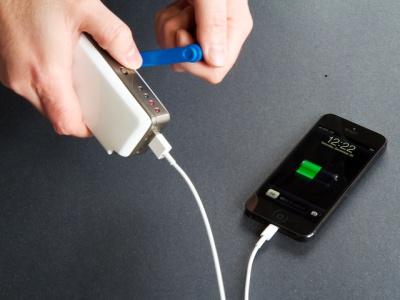
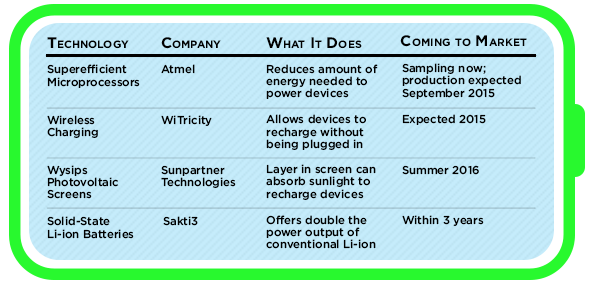
Batteries: They never seem to last long enough or are fully charged when we need them the most to power our phones, laptops or tablets. But that will change in the coming years, as several new technologies take power delivery to new heights and open up possibilities like phones that run for days or electric cars that go and go.
"Following years of slow and steady evolutionary improvements, batteries could be on the verge of a big revolution," said Vishal Sapru, research manager for energy and power systems at San Antonio-based Frost & Sullivan. "By re-engineering how batteries work, we could easily see double or triple the capacity of current batteries over the next few years."
But that's all that’s coming down the pike for the power-mad among us. In addition to longer-lasting batteries, expect to see novel ways to top off the cells of a phone or computer. This includes clear solar cells embedded in displays as well as a way to transmit power wirelessly.
Today we may strive for full-day use of a notebook, but if these breakthroughs pan out, they could translate to two or three days of battery power on a charge. "It may not be time to throw away the AC adapter," Sapru said, "but it could be enough to be able to go for a couple of days without a charge."
In other words, it might be time to say goodbye to battery anxiety.
Sulfur Batteries for Longer Life
While most existing battery tech focuses on improving the lifespan and charging speeds of lithium batteries, Sony has been working on using sulfur-based electrodes for better capacities. The new types of batteries could offer 40 percent more energy than lithium-ion versions, according to Nikkei.
Sony is reportedly working on lithium-sulfur and magnesium-sulfur cells, and the latter variant could mean cheaper, safer batteries as magnesium is a more widely available material and lithium-based batteries degenerate over time to the point of becoming a fire risk, according to Engadget.
The developments from Sony's labs are promising, considering the Japanese company developed the first commercial lithium-ion battery that's so popular today. Sony is expecting to commercialize the sulfur-based batteries in 2020.
Charge Your Phone 10x Faster
Even the longest-lasting batteries run out of juice, and when that happens, you don't want to be stuck waiting for hours to get a full charge. Thankfully, a new development from Chinese phone maker Huawei could reduce that time to mere minutes. Huawei demonstrated a new configuration for a lithium-ion battery that it says can be charged 10 times faster than current batteries.
In a demonstration, the company charged a nearly empty 3000-mAh battery for five minutes, which brought the phone back to 48 percent of endurance. Huawei accomplished this by bonding heteroatoms to molecules of graphite in anodes, which the company says will increase the charging speed of batteries without decreasing energy density or battery life.
The company did not express a time frame in which it would make the new batteries available in its consumer products.
The Solid-State Battery
The soul of the digital machine is power, and when it comes to batteries, the devil is in the details, with many promising ideas that fail to pan out. The exception is the original lithium-ion cell battery that Sony and Asahi Kasei commercialized in the early 1990s and quickly became the standard for mobile electronics.
Over 25 years, scientists and engineers have improved this battery's capacity threefold, said Ann Marie Sastry, CEO of Ann Arbor, Michigan-based Sakti3. This improvement, however, has come at the expense of increasingly greater complexity. "It's hit the wall," she said. "The physics of batteries needs to change."
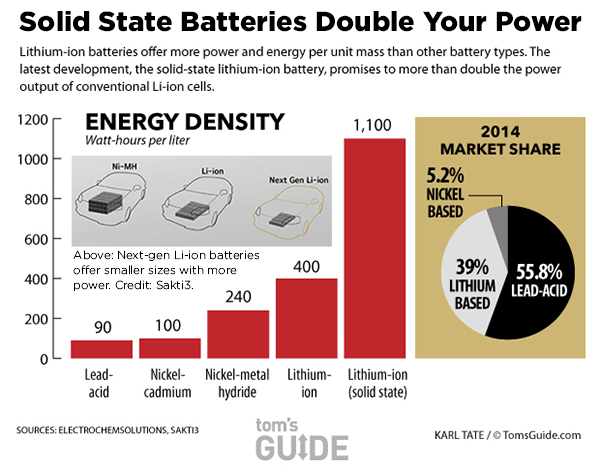
Sakti3's name is fitting because sakti means "power" in Sanskrit, and lithium's atomic number (how many protons the element has) is 3. The goal is to replace the paste electrolyte with solid material.
Made from a stack of solid layers, the Sakti3 prototype battery has an anode and cathode at the ends and a solid-state electrolytic layer in between, creating something akin to a battery sandwich. Rather than requiring exotic production equipment, the battery's layers are deposited individually onto a substrate using techniques similar to those employed in low-cost, thin-film processing, such as the method used to put the foil onto potato-chip bags. Rather than being made from battery parts that are assembled with an electrolytic paste in between, the Sakti3 design is built one layer at a time to create the electrodes and the electrolyte in between.
This new method could usher in an era in which the batteries are made right on the phone, tablet or notebook's circuit board, improving packaging, efficiency and reliability, Sastry said. "A solid-state battery can make the packaging of electronics much easier," she added.

Because the company is still in the process of commercializing the battery, details about it are scant. Sastry did say, however, that the new design raises the energy density to more than 1,100 watt-hours per liter — which is 10 times better than lead-acid or nickel-cadmium cells and four times more powerful than nickel-metal-hydride ones. It has two to three times the energy density of lithium-ion cells, she said.This new development presents the battery industry with an interesting choice between making a battery of the same size that can last two to three times longer on a charge than conventional cells, and producing batteries of the same capacity that are half or one-third the size. "You can make the devices smaller and lighter with a smaller battery, or more than double the time between charges," Sapru said. "It's a good problem to have."
With help from a $15 million investment by vacuum maker Dyson, these superbatteries could be available within three years, and could have a variety of uses.
A Battery With 5X the Power
One of the biggest complaints about battery technology is that it has stagnated; smartphones get thinner and battery life doesn't get better. That could change in the future, though, as a research out of the U.S. Department of Energy's Argonne National Laboratory has shown promise for lasting up to five times longer than today's lithium-ion batteries. The lithium-oxygen batteries are made of a stable form of lithium superoxide (LiO2).
"This discovery really opens a pathway for the potential development of a new kind of battery," said Larry Curtiss, one of the study's researchers in a press release.
Unlike current batteries, lithium-oxygen batteries don't require oxygen from the environment, which should make them stable and more efficient. They're still in the prototype stage, though, so smartphone owners will have to wait a bit for this new tech.
MORE: Lithium-Oxygen Batteries Could Give You 5x the Power
Finally a Use For Graphene
Graphene has been one of those magical materials that scientists have been talking about for years, but they’ve have had difficulty actually putting it to use. Graphene promises strength 200 times greater than steel by weight, has properties of both a conductor and an insulator, and is almost completely transparent. However, after being first produced reliably in 2003, even as recently as 2014, global sales of graphene had reached only $9 million.
Samsung hopes to change this by enhancing the traditional lithium-ion battery currently found in almost all of our devices through the addition of a silicon anode coated in graphene. Previous attempts to use silicon anodes saw improvements in capacity, but at the cost of faster degradation, as the silicon weakened quickly over a typical charge-discharge cycle.

Graphene helps increase longevity of this type of battery, resulting in usable batteries 1.5 to 1.8 times denser than what we have today. Even on the low end, this enhancement would conceivably push the battery life on a Galaxy S6 from 8 hours and 26 minutes to almost 12 hours and 45 minutes of real-world usage.
But like most battery breakthroughs, silicon graphene anodes aren't yet ready for market. Samsung says they are two to three years away from commercial production, but once ready, they should have a big impact on devices like smartphones and laptops, as well as electric cars.
Screen As Solar Charger
A new-wave battery is just the start, because you will soon be able to augment a device's power with a second source that can grab power out of thin air. That's the idea behind Sunpartner Technologies' Wysips, which turns the system's screen into a solar collector. It's similar to the way Casio solar watches are powered, but scaled up for phones, tablets, notebooks — and, eventually, electric cars.
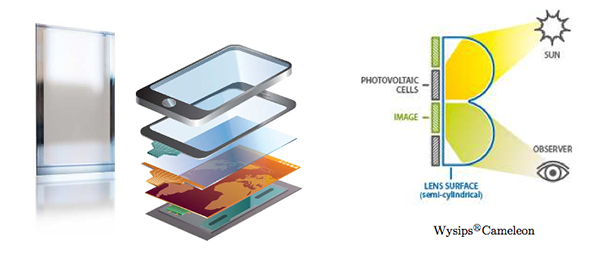
"Wysips' technologies are about energy harvesting to bring additional energy," said Matthieu de Broca, Sunpartner Technologies' marketing director in charge of screens and mobiles devices. Rather than doing away with or re-engineering conventional batteries and chargers, the Aix-en-Provence, France-based company aims to "provide a perpetual power reserve," de Broca said.
Under the surface, Wysips' Crystal technology adds a layer of micro lenses to the system's display that's roughly five human hairs thick. It fits between the LCD and the phone or tablet's touch-sensitive overlay. The system cleverly uses lenticular optics that can be seen only at the right angle, so the power-generating photovoltaic cells disappear. As a result, the glass is 90 percent transparent, and the typical user would be hard-pressed to even notice it.

At the moment, the solar cells can generate roughly 2.5 milliwatts per square centimeter in typical sunlight conditions. According to the company, after 10 minutes in the sun, the screen could generate enough electricity to power a phone for an extra couple minutes of talk time. That's just the start, de Broca said, because the technology will have a second-generation product ready for commercialization later this year that ups the power output by 60 percent to 4 milliwatts per square centimeter.
Scale it up to a tablet or notebook, and the payoff improves, because larger screens mean more power; the company has experimented with displays up to 13 inches. If the Microsoft Surface 3's 12.5-inch screen had today's Wysips Crystal screen, it could boost the battery with 1 watt of additional power as long as the sun were shining.
So far, the company has demonstrated its technology on Bookeen e-book readers and nevo watches. But it all came together at this year's Mobile World Congress, when the company showed a Kyocera Torque E6710 phone with a solar screen to augment its battery. Scaled up, this technology could be used for things like home and office windows, car windshields and moonroofs.
MORE: 10 Laptops with the Longest Battery Life
There might even be a broadband bonus: In addition to power, Wysips can send and receive data using the company's Li-Fi communications scheme. Whereas Wi-Fi uses 2.4- or 5-GHz transmissions, Li-Fi modulates light that can connect with a broadcasting base station in a home or office. "We can achieve several megabits per second, de Broca said. "Researchers have reached data rates of 10 gigabits per second in the lab."
There's no commercially available equipment for this technology, and Wi-Fi will be a tough competitor. The bonus is that this communications portal can be self-powered by the screen's solar cells.
Wireless Electricity
But what do you do in the dark? That's where tech like WiTricity comes in. Based on coupled magnetic resonance technology, it is the next step after the inductive power transfer that's used for products like electric toothbrushes and Qi phone power mats.
Conceptually, the WiTricity gear is like a transformer with the central core removed and the coils (or loops of wire) separated. One gets installed in the transmitting unit, and the other is installed in the receiver. When the electromagnetic fields of the two coils overlap, one loop can induce a current to flow in the other, without the two loops having any physical connection to each other. WiTricity boosts this induction by having the fields resonate at 6.78 MHz.

"It uses a pair of loops [one for sending and another for receiving power], but takes this idea a step farther by coupling the magnetic fields of the transmitter and receiver," said Grant Reig, senior product manager at WiTricity. The Watertown, Massachusetts-based company has demonstrated setups that are as far apart as 7 feet for transmitting enough juice to light a 60-watt bulb.
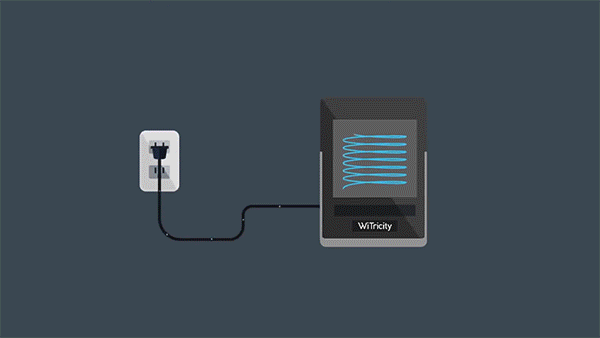
While pure inductance charging requires that the sender and receiver be right next to each other, WiTricity's two loops can be up to a couple of inches apart and even be separated by wood or plastic. The electromagnetic fields can't go through most metals, but they can travel around obstacles.
Reig said the first use of this technology will likely be in furniture. The company's WiT 5000 Development Kit can charge a pair of iPhones at 5 watts each through a wooden desktop. However, because there aren't yet any phones that have the receiving equipment built in, the phones need to be in a sleeve that contains WiTricity's receiver and a connection to the device's power port.
"The idea is that you'll have a WiTricity transmitter in every room, so you're never too far from a charger," Reig added. If the idea catches on, phones, tablets and notebooks will have the receiver built in, and coffee shops, hotels and offices will incorporate the transmitting technology.
MORE: 10 Smartphones with the Longest Battery Life
The next step will be to put the transmitter in more creative places. Because there doesn't need to be contact between the sender and the receiver, one day, you could just drop your phone into a bowl, for example, to allow it to charge. "Better yet, how about using the car's cup holder to give your battery a charge?" Reig said.
Getting WiTricity's juice to flow starts with a Bluetooth data handshake to let the transmitter know the device's power requirements. Once the preliminaries are out of the way, power flows from the transmitter to the receiver. "It's like magic," Reig said. "With this technology, your battery never has to go dead, and you can leave your AC adapters behind."
WiTricity’s technology provides the backbone of the Rezence wireless charging specification. WiTricity does not create its own products. Instead, its technology is licensed by major brands who work with WiTricity to bring them to market. The Rezence spec was only recently completed, and chipsets from multiple vendors are starting to appear. WiTricity expects to see Rezence-enabled products on the market in 2015, but it didn't want to comment on its licensees' go-to-market plans.
Superefficient Chips
Better batteries and augmentation technologies are a good start, but there is another route to longer times between charges: cut how much power the device uses to the bare minimum, to put less stress on the batteries. For the past decade, every component — from screens to storage — has undergone a revolution that has yielded power savings. Now, it's the processor's turn.
While Intel Atom processors use just a few watts to run mobile gear, it's nothing more than a tantalizing tease. By contrast, Atmel's Sam L21 line of chips consumes 35 microamps per MHz of clock speed. Do the math, and it comes out to less than 1.5 milliamps for the processor that tops out at 42 MHz, or roughly three orders of magnitude less power than an Atom chip. When it's idle, the numbers are even more impressive, with the chip using only 8.4 microamps.
"We came at this from both sides," said Andreas Wieland, Atmel's director of product marketing. "We've cut power when it's being used to the minimum, and it uses even less when it's asleep."
Inside, the ARM-based processor has 256KB of memory and 32KB of RAM. It's being tapped for microsensor and controller tasks in the realm of the Internet of Things (such as wearable devices) because of its low power use. Because it uses the ARM instruction set, the Atmel chip might eventually grow to be used in phones, tablets or other mobile devices.
"Right now, it's a microcontroller with limited uses," Wieland added. "This is an ARM processor that's not all that different from those in phones in tablets, and might evolve in that direction." In other words, a phone that could go a week between charges might not be that far off.
Outlook
The bottom line is that new battery chemistry, along with innovative augmentation techniques, has put us on the verge of a tipping point in power technology. In addition to a three-day cellphone battery and an electric car with a 300-mile range, some batteries can be used to store the output of wind turbines and solar panels for when the power is needed.
"There are lots of things we can imagine but can't execute without a better battery," Sastry said. How about electric aircraft, robots and smart grids?” It's all out there waiting for the perfect battery to power it.
Sign up to get the BEST of Tom's Guide direct to your inbox.
Get instant access to breaking news, the hottest reviews, great deals and helpful tips.
Brian Nadel is a freelance writer and editor who specializes in technology reporting and reviewing. He works out of the suburban New York City area and has covered topics from nuclear power plants and Wi-Fi routers to cars and tablets. The former editor-in-chief of Mobile Computing and Communications, Nadel is the recipient of the TransPacific Writing Award.
-
chicofehr There is like 10 new battery tech that is announced every year for many years back and we are still using plain lithium ion batteries. I'll believe it when it happens.Reply -
eklipz330 ReplyThere is like 10 new battery tech that is announced every year for many years back and we are still using plain lithium ion batteries. I'll believe it when it happens.
QFT -
fonzy ReplyThere is like 10 new battery tech that is announced every year for many years back and we are still using plain lithium ion batteries. I'll believe it when it happens.
I was going to say the exact same thing. That goes for other technology as well like solar technology, medical advancements that you been hearing for years that don't ever make the light of day. -
tomfreak wont happen, u wont get days of battery life, as soon as battery improve, the phone maker will make the phone thinner with smaller battery.Reply -
aReefer A few other ideas should also be mentioned in this context.Reply
Here in Israel, we have a startup called StoreDot (http://store-dot.com) that has created an organic battery that uses compounds derived from cancer research (believe it or not) that allow you to fully charge your phone battery in 60 seconds. That company is already in discussions with several large phone producers to market their tech.
Then there's wi-charge (http://www.wi-charge.com) that uses an infra-red beam to charge phones remotely - meaning no EM radiation or the associated potential heath risks.
These are just 2 examples. -
Tmpmds I don't get the point to Photovoltaic Screens. You never want to use your mobile or tablet or laptop screen on direct exposure to the sun. And you try to keep it on a bag and/or pocket when not using it, so I think this tech is non sense, except for big ads screens on highways.Reply -
csf60 "as several new technologies take power delivery to new heights and open up possibilities like phones that run for days"Reply
Ehhm.. Welcome to the 90s! -
Camikazi Replywont happen, u wont get days of battery life, as soon as battery improve, the phone maker will make the phone thinner with smaller battery.
That is true and I hate it, the new "ultra-thin" phones feel so fragile in my hands I think I will break it and have to put a bulky case on it to make it feel usable. They might as well just put a bigger battery in there and advertise the actual multi day charge. I would love a phone that is thicker but has a MUCH larger battery and run time. -
cats_Paw Worst problem about batteries is that they break down (and rather fast if not used correctly).Reply
It is estimated that if you leave a battery at FULL LOAD for a year it will lose 50% of its capacity. It will lose 2% if it would be at 30-40%.
This issue is something everyone who doesn't buy a mobile phone every year has experienced and its the main problem of things like solar power for your home (its expensive and you still have to replace batteries every 8-10 years.
The day a batt works for a month in a phone/laptop and in a year it degrades to 25 days it will be a breakthrough, those are minor upgrades/updates (they are helpfull non the less, so its not like Im angry, just saying this article is overhyping it).

